PLACES TO VISIT
Important tourist destinations around Hotel Oaktree
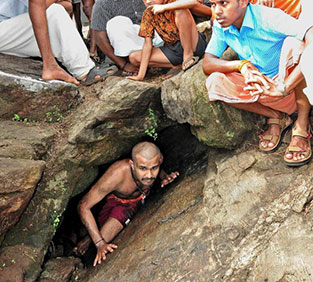
Punarjani Cave
Punarjani Guha (Punarjani Cave) is a mystical or holy place, open only once a year on Guruvayur Ekadashi, the Shukla Paksha Ekadashi day of the Vrichikam (November/December). The 150m long narrow cave is believed to have been built by VISWAKARMA, the legendary creator of Kerala. According to legend, Punarjani Guha was carved out by him on the orders of DEVENDRAN following the pray of Parasuram.
The Punarjani Noozhal, the crawling through the Punarjani cave, is an important local ritual. The crawl is said to be difficult, but to remove all sins from the devotee. Only men are allowed to do the noozhal, women can visit the cave but will not get rid of their sins. The devotees first cleanse their body by bathing in the Papanasini Thirtham. Then they enter the cave without a light, in the dark they need about 45 minutes to reach the other end. Then they cleanse their body by bathing again in Papanasini Thirtham and thereafter dip in Pathalathirtha located at the starting point of the Punarjani.
Punarjani is located about 2 km from the Thruvilwamala temple.
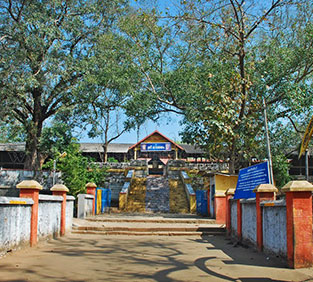
Vilwadrinatha temple
The name of the town is originated from the temple and it is a famous pilgrim spot.Lord Rama, the seventh avatar of Lord Vishnu, and his brother Lord Lakshmana are the main deities of this temple. This is one of the four major temples in Kerala dedicated to Lord Rama, the other three beingThriprayar, Kadavallur and Thiruvangad temples, and also one of the rarest temples in India itself which houses Lord Lakshmana. The temple is situated on the middle of Thiruvilwamala village, on the top of a hill 100 ft above the sea level. Bharathappuzha, the second largest river in Kerala, flows through the northern side around 3 km away from the temple, and as the temple is situated on the top of a hill, the river can be clearly seen from the temple.
The temple is situated around 50 km away from Thrissur city, the district headquarters, and 35 km away from Palakkad. There are bus services from both cities. It is 25 km away from Wadakkanchery, the Taluk headquarters. The nearest railway station is at Lakkidi, just on the opposite bank of Bharathappuzha, but the major railway stations nearby are at Ottappalam(14 km), Shoranur (20 km) and Wadakkanchery (25 km). The area is under the control of Pazhayannur police station, and Thiruvilwamala revenue village.
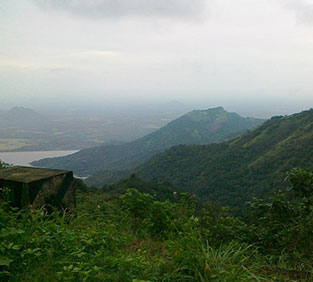
Nelliyampathy Hills
From the town of Nenmara in Palakkad district, the cloud-caressed peaks of the majestic Nelliyampathy hill ranges are a sight to behold. The height of the hills ranges from 467 m to 1572 m. To reach Nelliyampathy, one has to take the road starting from Nenmara that proceeds to the Pothundy Dam.
There are about 10 hairpin bends that have to be negotiated on the way to Nelliyampathy.The Pothundy Dam is a picturesque locale with facilities for boating and is a nice option as a picnic place. As the Ghat road winds its way up to Nelliyampathy, at certain places there are viewpoints from where the vast stretches of Palakkad district are visible with its extensive paddy fields forming a verdant carpet. It also offers a splendid view of the Palakkad Gap, which is a geographical phenomenon in the Western Ghats formation in this region, bringing into view, parts of the adjoining State of Tamilnadu.
On the way up, those interested in bio farming can take a close look at the privately managed farms and also vast expanses of tea estates managed by different plantation companies. The hills of Nelliyampathy are also well known for its orange cultivation.
Privately owned hotels and resorts are located at various points, as one goes up the hills of Nelliyampathy. The bio-farms located here are a major landmark as one proceeds up before reaching the topmost point at Palagapandi estate. The estate has a quaint bungalow, built during the period of the British rule in India, and has now been converted into a private owned resort. At Kaikatty, a community hall is available, which is usually used as a base by those interested in trekking.
Not far away from Palagapandy is Seetharkundu where one can have a fantastic valley view, and a 100 m high waterfall providing an added attraction. From Palagapandy, one can trek or go by jeep to reach Mampara; another breathtaking vantage point at Nelliyampathy. The area in and around Palagapandy estate has tea, cardamom and coffee plantations with adjoining hills allowing one to catch a glimpse of the wildlife in the form of Indian gaur, elephants, leopards, giant squirrel etc. and is also a paradise for birdwatchers.
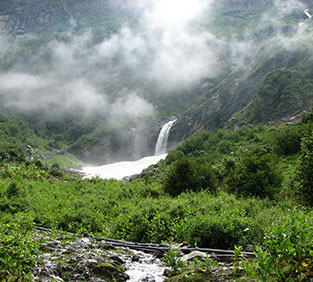
Silent Valley National Park
Silent Valley is a national park with a core zone of 236.74 square kilometres (91 sq largest national park in Kerala). It is located in the Nilgiri Hills, within the Palakkad District of Kerala, South India. This region was explored in 1847 by the botanist Robert Wight,[1] and is a setting for the epic Mahabharatha.
This park is one of the last undisturbed tracts of South Western Ghats mountain rain forests and tropical moist evergreen forest in India. Contiguous with the proposed Karimpuzha National Park (225 km2) to the north and Mukurthi National Park (78.46 km2) to the north-east, it is the core of the Nilgiri International Biosphere Reserve (1,455.4 km2), and is part of The Nilgiri Sub-Cluster (6,000+ km2), Western Ghats World Heritage Site, recognised by UNESCO in 2007.[3]
Plans for a hydroelectric project that threatened the park's rich wildlifestimulated an environmentalist social movement in the 1970s, known as the Save Silent Valley movement, which resulted in cancellation of the project and creation of the park in 1980. The visitors' centre for the park is at Sairandhri.
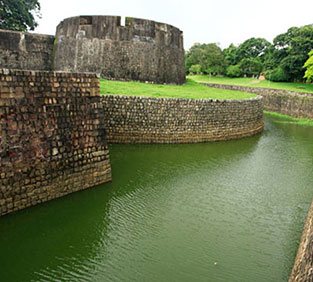
Palakkad Fort
Palakkad Fort also known as Tipu's Fort is an old fort situated in the heart of Palakkad town of Kerala state, southern India. It was built by Haider Ali in 1766 ACE and remains one of the best preserved forts in Kerala.
There is a large ground between the Fort and the Palakkad Town hall, known as Kota Maidanam (Fort Grounds). The ground, which had once served as a stable for the elephants and horses of Tipu's army, is now used to stage cricket matches, exhibitions and public meetings. An open air auditorium called "Rappadi", currently under the preservation of theArchaeological Survey of India, is also located within the spacious grounds of the Fort. Additionally, there is a children's park on one side of the Fort.

Kuthampully Handloom Village
A traditional cotton weaver’s village with around 600 Brahmin families, Kuthampully is well knownfor kasavu handloom weaving. Kuthampully saris are a favourite among womenfolk not only in Kerala, but also in other parts of the country.
Kuthampully Handloom Industrial Cooperative Society was registered in Kuthampully village, on the banks of the legendary Bharathapuzha, in the Thiruvilwamala Panchayat , in the year 1972 with 102 members. They followed the traditional path in the early days and their different kinds of Indian clothings like kasavu double dhoti, veshti and set mundu became popular. Later on, embroidery techniques have been deftly applied on traditional Kuthampully sarees to produce designer ones. At present around 3000 people are employed in this sector mostly through cooperatives and as small-scale entrepreneurs.
Kuthampally is situated about 50 km northeast of Thrissur town.Nearest railway station: Shoranur, about 29 km
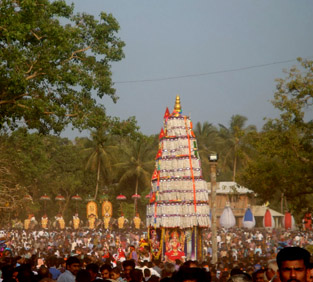
Chinakkathur Pooram
Chinakkathur pooram is an eagerly awaited festival in the Palakkad region. Pooram is celebrated with much fanfare, pageantry and a famous fireworks (pyrotechnical display) during the month of Kumbham.
The procession of horse effigies (Kuthiravela), caparisoned elephants and a large contingent of drummers (vaadyamelam) add colors to the festivities. The Bhagavathy temple with Chinakkathoor Bhagavathy as the principal diety is greeted by the thronging procession.
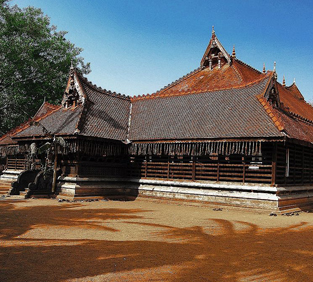
Kerala Kalamandalam, Cheruthuruthi
Deemed a University of Art and Culture by the Government of India, is a major center for learningIndian performing arts, especially those that developed in the Southern states of India, with the special emphasis on Kerala. It is situated in the small town ofCheruthuruthy in Thrissur, Thrissur District on the banks of theBharathapuzha river.
The inception of Kalamandalam gave a second life to three major classical performing arts of Kerala as Kathakali, Kudiyattam and Mohiniyattam were, by the turn of 20th century, facing the threat of extinction under various regulations of the colonial authorities.[1] It was at this juncture, in 1927, that Vallathol Narayana Menon and Mukunda Raja came forward and formed a society called Kerala Kalamandalam. They solicited donations from the public and conducted a lottery in order to raise funds for this society.[2] Kerala Kalamandalam was inaugurated in November 1930 at Kunnamkulam, and was later shifted to the village of Cheruthuruthy, just south of Shoranur in 1933.
The Maharaja of Cochin donated land and a building. Subsequently, a dance department was started to revive Mohiniyattom. Kerala Kalamandalam has been functioning as a grant-in-aid institution under the Cultural Affairs Department, Government of Kerala. In 2006, the Kalamandalam was accorded the status of 'Deemed University for Art and Culture' by the Government of India. In 2010, University Grants Commission (India) has given 'A' category status for Kerala Kalamandalam. Kalamandalam is the only deemed university in Kerala state accorded the prestigious status.
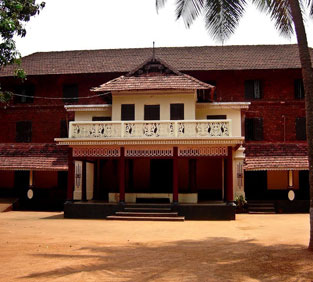
Varikkassery Mana
The Magnificent marvelous structure which speaks volumes of past glory in present tense that is Varikkassery Mana at Manisseri near Ottapalam in Palakkad district.
The traditional home of one of the most aristocratic Namboothiri families of Valluvanad. The heartthrob of erstwhile Malabar is known for its architectural beauty. The three building (Nalukettu, Southern Pathayappura, and Western Pathayappura), a very large pond with a beautiful pond house and a Sreekrishna temple, all stand on a serene atmosphere.
A visit makes you move to another world of peace, health and harmony.The Mana is known to many as a film shooting location for films of all Indian languages and one Hollywood production is soon to commence.

Anangan mala
Legend has it that, Hanuman in search of reviving Lakshmana during the Ramayana wars visited the mala in search of Kanmadam, but the hill refused to budge. That is how the name was bestowed on the hills. On a comparatively plain terrain, it still remains a mystery how the terrain had rocky obstacle emerging in between the palins and western ghats. Today the site is part of eco-tourism site and well maintained. There are placid water bodies, aboriginal hamlets and the elusive Kanmadam and many other rare herbs in the hills.
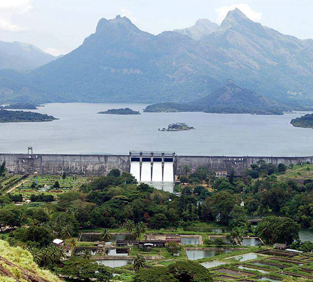
Malampuzha Dam & Gardens
Malampuzha is among the pioneering irrigational dams in Kerala meant to feed the parched farm lands of palghat. Now it has become touristic cynosure because of the expansive garden, the light and sound show, the iconic sculpture of Yakshi by renowned sculptor Kanayi Kunjiraman, the rock garden, snake park and the ropeway. The scenic place is close to Palghat town, Nelliyampathy hills and Silent Valley.
